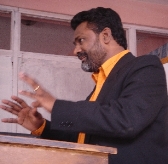 There is nothing called Hinduism. It is rather Hinduisms, because there isn’t one religion called ‘Hinduism’, but there is a multiplicity of religions within what we call Hinduism, ‘a parliament of religions’. It is a very complex system with many different and even contradictory belief systems within itself and hence I prefer ‘Hinduisms’. Rev. Sudhakar Mondithoka, Visiting Professor of 'Contemporary World Religions & Christian Apologetics' and 'Ethics' at SAIACS and Pastor of the English Congregation of Centenary Baptist Church, Secunderabad.
There is nothing called Hinduism. It is rather Hinduisms, because there isn’t one religion called ‘Hinduism’, but there is a multiplicity of religions within what we call Hinduism, ‘a parliament of religions’. It is a very complex system with many different and even contradictory belief systems within itself and hence I prefer ‘Hinduisms’. Rev. Sudhakar Mondithoka, Visiting Professor of 'Contemporary World Religions & Christian Apologetics' and 'Ethics' at SAIACS and Pastor of the English Congregation of Centenary Baptist Church, Secunderabad.
The Six Philosophical Schools (Shad-Darsanas) and Others of IndiaThese are divided into two categories – Asthika (Orthodox or theistic) and Nasthika (Heterodox or atheistic) – ‘Asthika’ means one who believes in 1) Life after death, 2) God, and 3) the Authority of the Vedas and ‘Nasthika’ means the opposite of these, basically one who does not believe in God. The orthodox are mainly those who believe in the authority of the Vedas.
The Shad Darsanas: The Nyaya,(or Tarka) founded by Gotama or Gautama (who wrote Nya-Sutra) in/around 4th Century BC , atheistic and resembles Vaiseshika – logical or rational analysis of the world. Also deals with epistemology partly.
Vatsyayana’s Nyaya-Bhasya is the second important text. There are 4 means of valid knowledge (Pramanas): Perception (pratyaksha), inference (anumana), comparison (upamana), and testimony (sabda). There is a God who created the world and there is a plurality of soulsThe Vaiseshika, . Kanada (who wrote Vaiseshika sutra) in/around 4th Century BC, atomic school, means ‘particularity’ – according to this natural philosophy the universe is made of 9 elements/substances (earth, water, air, fire, soul/spirit, mind, ether, time and space) out of which God created the world.
Reality is classified into six categories (padarthas): substance, quality, action, universality, particularity, and inherence (and the seventh non-existence!).The Sankhya . . . Kapila in/around 7th Century BC, oldest – recognizes no personal God, emphasizes logic and inference, and says that the universe is made up of two elements: purusha (spirit) and prakriti (matter), which are eternal and thus it is dualistic. But it accepts a multiplicity of eternal purusas and prakriti creates bodies and personalities for them.
Prakriti has three gunas (qualities): Sattva (goodness or purity or being or reality), rajas (energy or passion), and tamas (inertia or dullness or darkness). This is closely linked to yoga, which is necessary for the purusas to be released from the prakriti.The Yoga .Patanjali . . . 2nd Century BC – close to sankya and accepts it and it is a system of mind control as a means of attaining moksha or union with Brahman. Yoga, coming from Yuj, means a yoke or union. No concept of a personal God.
It is a eight-step process (Astanga-yoga) wherein the first five (hata-yoga) are conscious external disciplines and the last three (raja-yoga) are internal disciplines.Mimamsa (or Purva-mimamsa = the original or first investigation) . . . Jaimini in/around 4th Century BC – developed from speculation about the parallelism between cosmic processes and ritual action and there is great emphasis on Vedic rituals and sacrifices like Yagna, the ritual of sacrifice. It regards the Vedas as eternal and uncreated and believes that if all preliminary disciplines and set rules are observed, correct ritual action brings about guaranteed results, including salvation.
The Vedanta (or Uttara-mimamsa, the later investigation): Badarayana or Vyasa . . . 4th Century BC. This is the philosophy derived from the Upanishads (the end portions of the Vedas). An essential aspect of this Upanishadic though is the ultimate unity between the self and the universal self or atman and Brahman or jeevatma and paramatma. There are three main schools within this: Advaita Vedanta of Sankara, Visista Advaita of Ramanuja (11th – 12th C. AD) and Dvaita of Madhva (12th – 13th C. AD).
According to Dvaita reality is dual or two: dependent (matter) and independent (God) and the self is responsible for its own release from countless reincarnations by devotion to God. Ramanuja was a devotee of Vishnu and for him God is not an unqualified principle, but a very personal God who can be loved and understood through devotion.
The others India schools are: 1) Buddhism, 2) Jainism, and 3) Charvaka schools are atheistic or nasthika schools.
Charvaka School is the materialistic philosophy which emphasises eating, drinking, and making merry – the goal of life is maximum happiness and minimum pain. This school denies the existence of God, soul, spirit and life after death, because of the belief that only that which is known through the sense perception is real. Ethics for them is simple: the actions that bring happiness are good and others are bad and good life consists of health, wealth and their fullest enjoyment.
To be continued…
Click here to read the Part 1
{moscomment}





hi,,
This article is very intresting and moreover it gave me a brief idea about hinduism….it also helped me to answer some of the questions which i am facing as a christian
Dear Br. Sudhakar, Thanks for this informative piece. Though we are living among our Hindu brethren most of their religious teachings are ignorant to us. You’ve given a lot of facts about this much misunderstood religion. Well researched and well written articles. Anxiously waiting for the next installment. May God bless you with His wisdom. Thanks to Sakshi too. Keep it up. pvariel@gmail.com
Dear Brother Mr.Sudhakar thanks for the information regarding Hinduism , its good to know where we are living in India , its helpfull to preach Personal evangelism in North India.
Anna you are praying for you .
Malyadri
Raxaul
East Champaran DIST.
Bihar